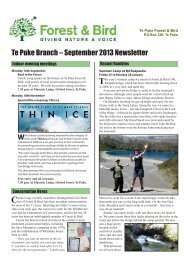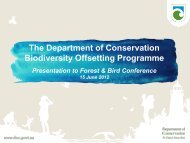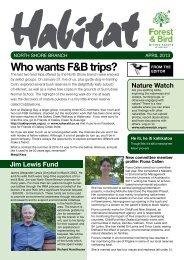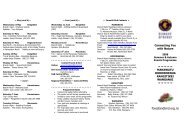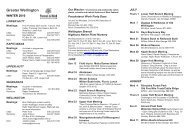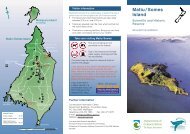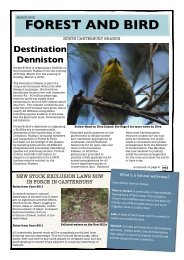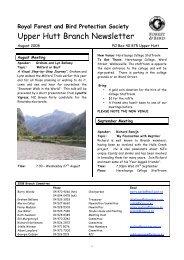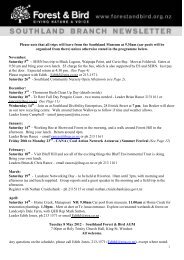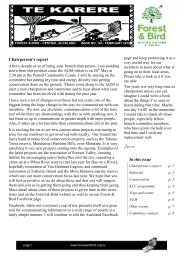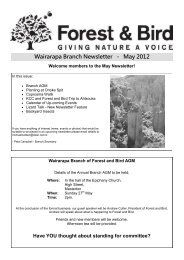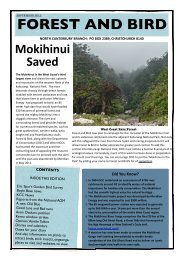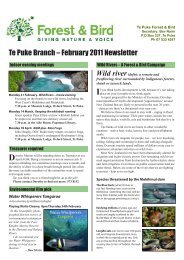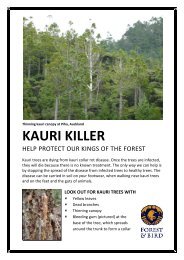methodology - Forest and Bird
methodology - Forest and Bird
methodology - Forest and Bird
You also want an ePaper? Increase the reach of your titles
YUMPU automatically turns print PDFs into web optimized ePapers that Google loves.
BMEY – the recruited biomass that supports the maximum economic yield.<br />
ESY – Ecologically sustainable yield – the yield an ecosystem can sustain without shifting to an<br />
undesirable state.<br />
MSY - Maximum sustainable yield, in relation to any stock, means the greatest yield that can be<br />
achieved over time while maintaining the stock's productive capacity, having regard to the<br />
population dynamics of the stock <strong>and</strong> any environmental factors that influence the stock:<br />
(section 2, Fisheries Act 1996)<br />
OSY – Optimum sustainable yield is the yield which considers factors in addition to maximum<br />
sustainable yield, for instance, effects on other species in the ecosystem <strong>and</strong> of other human<br />
uses of the ecosystem.<br />
Biological reference points can be used to assess the sustainability or state of a stock, for example, the<br />
percentage of the unfished population remaining or the portion of eggs or pups produced when compared<br />
to the unfished population. In New Zeal<strong>and</strong> quantitative stock assessments the current biomass of a stock<br />
is usually compared to the unfished, unexploited or virgin biomass (Bo) (Cordue 2004, Ministry of Fisheries<br />
2008). New Zeal<strong>and</strong>’s harvest strategy also includes limit reference point on fishing mortality (e.g. FMSY).<br />
Reference point catch limits (e.g. current annual yield (CAY)) rely on agreement as to what constitutes an<br />
acceptable level of risk of stock decline below a certain size. These are usually defined in New Zeal<strong>and</strong><br />
stock assessments which state that the biomass should not have the risk of falling below 20% of unfished or<br />
virgin biomass (Bo) more than 10% of the time. This is known as the safety condition (Francis 1992 <strong>and</strong><br />
1999). As Francis (1999) noted “without this condition, BMAY <strong>and</strong> BMCY for southern blue whiting are 15% Bo<br />
<strong>and</strong> 17% Bo respectively…with the safety condition they are 29% Bo <strong>and</strong> 49% Bo”.<br />
The Ministry of Fisheries 2008 harvest strategy sets:<br />
“a specified target about which a fishery or stock should fluctuate; a soft limit that triggers the<br />
requirement for a formal, time-constrained rebuilding plan; <strong>and</strong> a hard limit below which fisheries<br />
should be considered for closure” (Ministry of Fisheries 2008a).<br />
However, there are elements of the strategy which may not be consistent with the legislative requirement<br />
to keep stocks at or above the MSY level (section 13(2)(a)).<br />
“The harvest strategy st<strong>and</strong>ard does not explicitly specify a %Bo target, <strong>and</strong> alternative %Bo targets<br />
will be acceptable, provided they can be adequately justified by, for example, considerations of stock<br />
productivity. However, it is becoming increasingly difficult to justify stock targets less than 30-40% Bo<br />
(or, equivalently, removing more than 60-70% of the unfished biomass).” (Ministry of Fisheries, 2008).<br />
In contrast the Australian harvest strategy (DAFF 2007) sets a proxy for BMSY at 40% Bo.<br />
Retaining stocks closer to their unfished size has been the outcome of the focus on precautionary fisheries<br />
management <strong>and</strong> including ecological considerations.<br />
Ecological impacts of reducing fish stocks on prey species or predator species have been important<br />
consideration of CCAMLR’s approach to fisheries management. In CCAMLR target levels have been set at<br />
50%Bo for predator species (e.g. toothfish) <strong>and</strong> 75%Bo for prey species (egg krill or icefish) (Constable et<br />
al.,., 2000).<br />
Reducing the impact on ecosystems <strong>and</strong> seabird predators has led to further support for retaining stocks at<br />
much higher biomass levels than Bmsy. Smith et al., 2011 noted that retaining stocks at higher levels (egg<br />
75%Bo) for low trophic level species had lower ecological impacts. They noted that “halving exploitation<br />
rates would result in much lower impacts on marine ecosystems while still achieving 80% of MSY”.<br />
Maintaining larger fish stocks also ensures the retention of larger older fish. Larger older female fish<br />
produce many more eggs that younger smaller females. The big old fat fecund female fish (BOFFF)<br />
<strong>Forest</strong> & <strong>Bird</strong> Best Fish Guide 2012 – 2013: Criteria for Ecological Rankings 9



